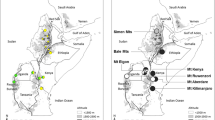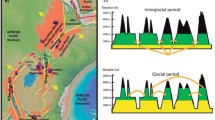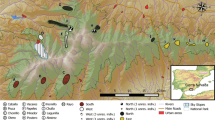Abstract
The flora on the afro-alpine sky islands is renowned for extreme fragmentation, representing a unique natural experiment in biogeography. Here we address the roles of isolation and gene flow, in particular across the narrow Rift Valley (the RV barrier) that cuts through the Ethiopian Highlands (EH), and across the vast low-lying landscape that separates EH from the East African mountains (the EH–EA barrier). We inferred the history of two species with different dispersal mechanisms, but with similar geographic ranges and habitats based on Amplified fragment length polymorphisms (AFLPs). Contrary to our predictions, we found that the populations from opposite sides of the RV barrier were less similar than those from opposite sides of the EH–EA barrier, and that only the supposedly short distance-dispersed species (Trifolium cryptopodium) showed a strong signal of secondary gene flow across the RV barrier. In the wind-dispersed Carduus schimperi, we rather found an evidence for the gene flow between differentiated populations inhabiting different EA mountains. Both species harbored little genetic diversity but considerable genetic rarity in several individual mountains, suggesting long-term isolation and bottlenecks during climatically unfavorable periods. Our genetic data corroborate a division of C. schimperi into three subspecies, but with new delimitation of their ranges, and of T. cryptopodium into two intraspecific taxa. Our findings support the idea that stochasticity may play a major role in shaping extremely fragmented ecosystems such as the afro-alpine. After initial colonization of different mountains, periods of isolation may alternate with unpredictable episodes of intermountain gene flow.



Similar content being viewed by others
References
Arctander P, Johansen C, Coutellec-Vreto MA (1999) Phylogeography of three closely related African bovids (tribe Alcelaphini). Mol Biol Evol 16:1724–1739
Assefa A, Ehrich D, Taberlet P, Nemomissa S, Brochmann C (2007) Pleistocene colonization of afro-alpine ‘sky islands’ by the arctic-alpine Arabis alpina. Heredity 99:133–142
Ayele TB, Gailing O, Umer M, Finkeldey R (2009) Chloroplast DNA haplotype diversity and postglacial recolonization of Hagenia abyssinica (Bruce) J.F. Gmel in Ethiopia. Plant Syst Evol 280:175–185
Barres L, Sanmartin I, Anderson C, Susanna A, Buerki S, Galbany-Casals M, Vilatersana R (2013) Reconstructiong the evolution and biogeographic history of Tribe Cardueae (Compositae). Am J Bot 100:867–882
Bonin A, Bellemain E, Eidesen PB, Pompanon F, Brochmann C, Taberlet P (2004) How to track and assess genotyping errors in population genetics studies. Mol Ecol 13:3261–3273
Brühl C (1997) Flightless insects: a test case for historical relationships of African mountains. J Biogeogr 24:233–250
Chorowicz J (2005) The East African rift system. J Afr Earth Sci 43:379–410
Coetzee JA (1964) Evidence for a considerable depression of the vegetation belts during the upper Pleistocene on the East African Mountains. Nature 204:564–566
Désamoré A, Laenen B, Devos N, Popp M, González-Mancebo JM, Carine MA, Vanderpoorten A (2011) Out of Africa: north-westwards Pleistocene expansions of the heather Erica arborea. J Biogeogr 38:164–176
Ehrich D (2006) AFLPdat: a collection of R functions for convenient handling of AFLP data. Mol Ecol Notes 6:603–604
Ehrich D (2007) Structure-sum v. 2007: A series of R functions for summarizing the outputs of the program Structure ver. 2.2. Unpublished, available from the author upon request
Ehrich D, Gaudeul M, Assefa A, Koch MA, Mummenhoff K, Nemomissa S, Brochmann C (2007) Genetic consequences of Pleistocene range shifts: contrast between the Arctic, the Alps and the East African mountains. Mol Ecol 16:2542–2559
Ellison NW, Liston A, Steiner JJ, Williams WM, Taylor NL (2006) Molecular phylogenetics of the clover genus (Trifolium–Leguminosae). Mol Phylogen Evol 39:688–705
Evanno G, Regnaut S, Goudet J (2005) Detecting the number of clusters of individuals using the software STRUCTURE: a simulation study. Mol Ecol 14:2611–2620
Excoffier LLG, Schneider S (2005) ARLEQUIN version 3.0: an integrated software package for population genetics data analysis. Evol Bioinform Online 1:47–50
Falush D, Stephens M, Pritchard J (2007) Inference of population structure using multilocus genotype data: dominant markers and null allele. Mol Ecol Notes 7:574–578
Fries TCE (1923) Beiträge zur Kenntnis der Flora des Kenia, Mt. Aberdare und Mt. Elgon. Notizblatt des Königl Botanischen Gartens und Museums zu Berlin 8:389–423
Gaudeul M, Taberlet P, Till-Bottraud I (2000) Genetic diversity in an endangered alpine plant, Eryngium alpinum L. (Apiaceae), inferred from amplified fragment length polymorphism markers. Mol Ecol 9:1625–1637
Gillett JB (1952) The genus Trifolium in southern Arabia and in Africa south of the Sahara. Kew Bull 7:367–404
Gillett JB, Polhill RM, Verdcourt B (1971) Leguminosae IIII. In: Milne-Redhead EE, Polhill RM eds. Flora of Tropical East Africa. London: crown agents for overseas governments and Administrations, pp 1016–1036
Gottelli D, Marino J, Sillero-Zubiri C, Funk SM (2004) The effect of the last glacial age on speciation and population genetic structure of the endangered Ethiopian wolf (Canis simensis). Mol Ecol 13:2275–2286
Hedberg O (1957) Afroalpine vascular plants. a taxonomic revision. Symb Bot Ups 15:1–411
Hedberg O (1969) Evolution and speciation in a tropical high mountain flora. Bot J Linn Soc 1:135–148
Hedberg O (1970) Evolution of the afroalpine flora. Biotropica 2:16–23
Hedberg O (1986) Origin of the afroalpine flora. In: Vuilleumier F, Monastero M (eds) High altitude tropical biogeography. Oxford University Press, New York, pp 443–468
Hedberg I, Hedberg O (1977) Chromosome numbers of afroalpine and afromontane angiosperms. Bot Not 130:1–24
Jakobsson M, Rosenberg NA (2007) CLUMPP: a cluster matching and permutation program for dealing with label switching and multimodality in analysis of population structure. Bioinformatics 23:1801–1806
Jeffrey C (1968) Notes on Compositae: III. The cynareae in east tropical Africa. Kew Bull 22:107–140
Jeffrey C, Beentje HJ (2000) Compositae I. In: Beentje HJ (ed) Flora of tropical East Africa. Balkema, Rotterdam, pp 46–54
Kadu CA, Schueler S, Konrad H, Muluvi GM, Eyog-Matig O, Muchugi A, Williams VL, Ramamonjisoa L, Kapinga C, Foahom B, Katsvanga C, Hafashimana D, Obama C, Geburek T (2011) Phylogeography of the Afromontane Prunus africana reveals a former migration corridor between East and West African highlands. Mol Ecol 20:165–178
Kadu CA, Konrad H, Schueler S, Muluvi GM, Eyog-Matig O, Muchugi A, Williams VL, Ramamonjisoa L, Kapinga C, Foahom B, Katsvanga C, Hafashimana D, Obama C, Geburek T (2013) Divergent pattern of nuclear genetic diversity across the range of the Afromontane Prunus africana mirrors variable climate of African highlands. Ann Bot 111:47–60
Kazmi SMA (1963) Revision der Gattung Carduus (Compositae), Teil I. Sonderdruck aus den Mitteilungen der Botanischen Staatssamlung München 5:139–198
Kebede M, Ehrich D, Taberlet P, Nemomissa S, Brochmann C (2007) Phylogeography and conservation genetics of a giant lobelia (Lobelia giberroa) in Ethiopian and Tropical East African mountains. Mol Ecol 16:1233–1243
Koch MA, Kiefer C, Ehrich D, Vogel J, Brochmann C, Mummenhoff K (2006) Three times out of Asia Minor: the phylogeography of Arabis alpina L. (Brassicaceae). Mol Ecol 15:825–839
Kosman E (2003) Nei’s gene diversity and the index of average differences are identical measures of diversity within populations. Plant Pathol 52:533–535
Nei M, Li WH (1979) Mathematical model for studying genetic variation in terms of restriction endonucleases. Proc Natl Acad Sci USA 76:5269–5273
Nybom H (2004) Comparison of different nuclear DNA markers for estimating intraspecific genetic diversity in plants. Mol Ecol 13:1143–1155
Popp M, Gizaw A, Nemomissa S, Suda J, Brochmann C (2008) Colonization and diversification in the African ‘sky islands’ by Eurasian Lychnis L. (Caryophyllaceae). J Biogeogr 35:1016–1029
Pritchard JK, Stephens M, Donnelly P (2000) Inference of population structure using multilocus genotype data. Genetics 155:945–959
Rohlf F (2000) NTSYSpc: Numerical Taxonomy and Multivariate Analysis System. Version 2.11a. Setauket (NY): Exeter Software
Rosenberg NA (2004) DISTRUCT: a program for the graphical disply of population structure. Mol Ecol Notes 4:137–138
Schönswetter P, Tribsch A (2005) Vicariance and dispersal in the alpine perennial Bupleurum stellatum L. (Apiaceae). Taxon 54:725–732
Tadesse M (2004) Asteraceae (Compositae). In: Hedberg I, Friss I, Edwards S (eds) Flora of Ethiopia and Eritrea. Addis Ababa University, The National Herbarium, Addis Ababa
Thulin M (1989) Subfamily Papilionoideae (Faboideae). In: Edwards S, Hedberg I (eds) Flora of Ethiopia and Eriteria. The National Herbarium, Addis Ababa University/Department of Systematic Botany, Uppsala University, Uppsala, Addis Ababa
Van de Peer Y, De Wachter R (1994) TREECON for Windows: a software package for the construction and drawing of evolutionary trees for the Microsoft Windows environment. Comput Appl Biosci 10:569–570
Vos P, Hogers R, Bleekwe M, Reijians M, Lee T, Hornes M, Frijters A, Pot J, Peleman J, Kuiper M, Zabeau M (1995) AFLP a new techinique for DNA fingerprinting. Nucleic Acids Res 23:4407–4414
Gizaw A, Kebede M, Nemomissa S, Ehrich D, Bekele B, Mirré V, Popp M, Brochmann C (2013) Phylogeography of the heathers Erica arborea and E. trimerain the afro-alpine ‘sky islands’ inferred from AFLP and plastid DNA sequences. FLORA 208:453–463
Yalden DW (1983) The extent of high ground in Ethiopia compared to the rest of Africa. SINET 6:35–38
Acknowledgments
This study is part of the project ‘AFROALP-II—Afro-alpine ‘sky islands’: genetic versus taxonomic biodiversity, climate change, and conservation’ funded by The Norwegian Programme for Development, Research and Higher Education (NUFU; project no 2007/1058) to S. Nemomissa and C. Brochmann. We thank the other members of the AFROALP-II team for discussions and help during the fieldwork. Sincere thanks are due to Mats Thulin and Manuel Pimentel who determined/verified the identity of our Trifolium and Carduus collections, respectively, and to Desalegn Chala for producing the base map.
Author information
Authors and Affiliations
Corresponding author
Additional information
T. Wondimu and A. Gizaw should be considered shared first authors.
S. Nemomissa and C. Brochmann should be considered shared senior authors.
Appendix 1
Appendix 1
See Table 4.
Rights and permissions
About this article
Cite this article
Wondimu, T., Gizaw, A., Tusiime, F.M. et al. Crossing barriers in an extremely fragmented system: two case studies in the afro-alpine sky island flora. Plant Syst Evol 300, 415–430 (2014). https://doi.org/10.1007/s00606-013-0892-9
Received:
Accepted:
Published:
Issue Date:
DOI: https://doi.org/10.1007/s00606-013-0892-9




